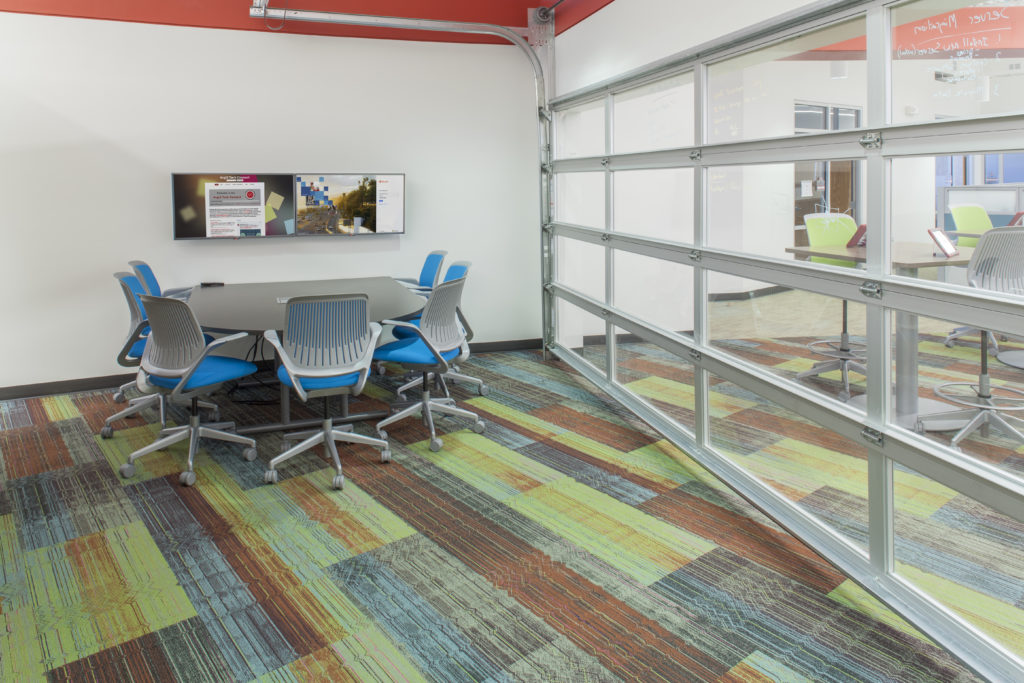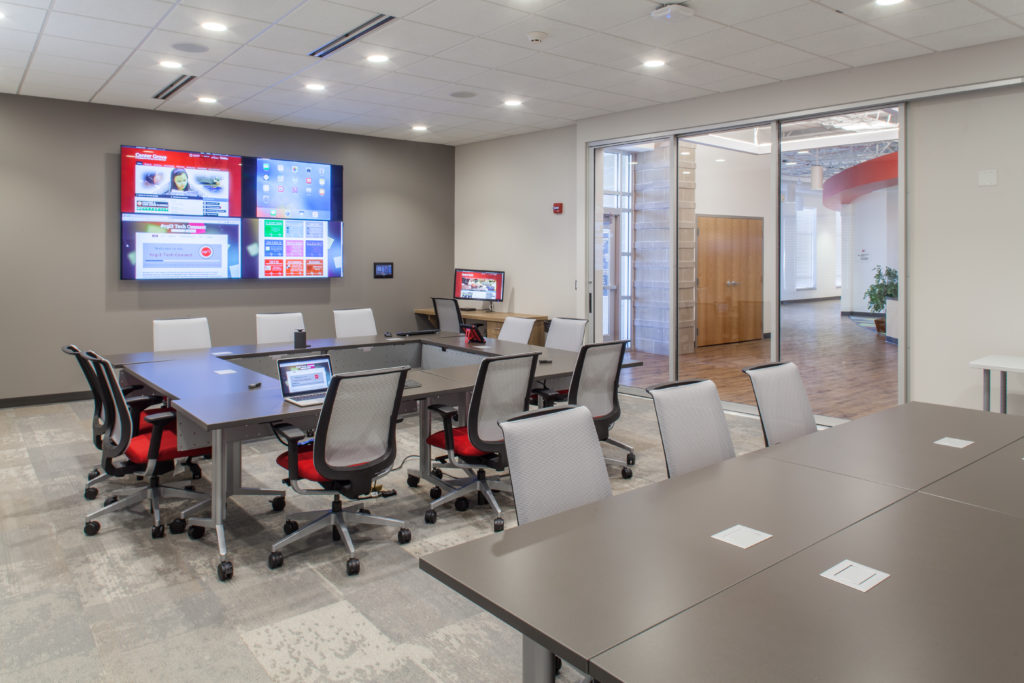In the previous articles in this series, we discussed both the criteria we’ll be using to assess the effectiveness of furniture in technology-rich learning environments. We defined technology-enabled furniture as purpose-built to provide dedicated and permanent locations for technology necessary to the operation of the learning space and identified the five criteria for evaluation as standardized connections, equipment mounting, cable routing, field serviceability, and ADA compliance. Please see the Spring 2021, Summer 2021, and Winter 2022 issues of Essentials for more.
Bringing our series to a close, this article will focus on huddle spaces, collaborative spaces, and informal learning spaces. While those may initially seem the easiest to assess, as we examine smaller spaces, it turns out technology is just as important to users and can be even more difficult to integrate.
Just a year or two ago, huddle spaces and other informal learning spaces were seen as locations where students would go individually or in small groups to work on course projects, study for exams, or just hang out and use the Wi-Fi. Today, with the widespread adoption of hybrid and hyflex teaching, these same informal spaces are now often primary locations for attending classes. Students now often prefer to join and participate in their classes from collaboration spaces in the next building over because of the more comfortable seating and proximity to coffee than to sit at a traditional desk in the classroom. Bandwidth aside, if students prefer the learning experience from a laptop in a huddle space, who are we to argue?

If these previously-informal learning spaces are now going to be primary learning spaces, then we must consider the full array of appropriate connectivity, mounting locations, wiring pathway, easy access for maintenance, and ADA compliance. As an added challenge, informal spaces are often only funded for renovations, remodels, and upgrades as part of larger capital projects. Furthermore, despite their increasing use as primary learning spaces by students, informal spaces are not usually on the radar of college or university administration for those upgrades or changes. That means it will fall to local IT staff to make any necessary modifications to support hybrid and hyflex learning in existing informal spaces. As one of those local IT staff, I use the same criteria to assess the furniture for technology integration as I would in larger, more formal learning spaces.
If we examine connectivity in informal spaces, we can separate those into two categories: AV and power. AV is still the exception in informal spaces because they are conceived and constructed for students to bring their own technology with them. There’s no reason to provide anything beyond a basic monitor with an available input when the students will be bringing their own laptops, tablets, and smartphones. In addition, informal spaces don’t need complicated switching or control systems. Speaking from experience, I’ve removed dozens of those from overly-complex huddle spaces over the years and it always improves the experience. If students are going to bring their own technology and want simply to sit down, plug into power, and connect to a large monitor, why make it any more complex than that? Provide an easily accessible HDMI port and AV is done.
If students are going to bring their own technology and want simply to sit down, plug into power, and connect to a large monitor, why make it any more complex than that? Provide an easily accessible HDMI port and AV is done.
Of course, all that BYOD technology requires charging, so for power, provide readily available NEMA 5-15 110VAC receptacles. I can hear you now saying, “and USB,” and while I want to agree, USB is still a bit of a challenge. Despite the U-for-Universal in USB, there are so many USB form factors and standards that it’s tough to determine a preferred connection. USB-A (aka “old USB”) is still widely used but is generally limited to 5W charging (5v @ 1A) and USB-C (aka “new little USB”) is a mess of standards and protocols (PD2, PD3, power, video, audio, data, etc.). Inductive charging (aka “wireless charging”) can be a good alternative, though that can raise many of the same power delivery issues.
The reduction in AV in informal spaces also means a reduction in mounting requirements for equipment. In most informal spaces there probably isn’t much equipment to be mounted, and there likely isn’t much in the way of fixed locations to do so anyway. However, mounting requirements are still a critical component of technology-enabled furniture. Mounting locations must be secure from tampering, strong enough to support the weight and bulk of any necessary equipment, and yet easily accessible for maintenance or troubleshooting (more on that later). If there’s a display as part of the furniture in an informal learning space, then that likely means a large vertical extension for the display location, but because huddle spaces and collaborative spaces are often in open areas and easily viewable from the side, simply stuffing technology components behind the display isn’t the most visually pleasing option. A cavity or cabinet behind the display where any necessary equipment can be mounted, and where any cabling can be hidden is a welcome option. If you’re wondering where we recommend the best place to mount larger AV equipment, such as a switcher or processor, the correct answer to that is in a cardboard box in your warehouse or in a proper equipment rack in another building as part of an unrelated project. Don’t over-complicate informal spaces with too much technology.

Similarly, the general reduction in technology leads to a reduction in necessary wiring pathway. Any AV input locations will likely be close to the display, so wiring should be at a minimum, but there are always exceptions. In larger huddle spaces with larger furniture — perhaps with a table device for input and power locations (and maybe a data connection, but it’s all Wi-Fi these days) — the pathway from the input location to the display should still be in a dedicated channel that is both easy to run replacement cables and has limited access sufficient to keep “helpful” students out. Please see the previous article in this series, Conference Room Furniture, for more on table devices.
Even reduced technology must be easily maintained. As mentioned previously, in huddle or collaborative spaces with a display, the area behind the display becomes the common location for technology components to be installed. If that display location provides additional equipment storage locations, then making that location easily accessible for maintenance via partially removable panels or entire demountable sections is a great option. For more involved maintenance, standard threaded bolts or thumb screws are a good choice. Basically, any equipment and cabling locations should be quickly accessible via simple hand tools.
One of the attractions for students to use informal learning spaces and huddle spaces is the soft seating and the general “living room” feel.
The final item we must review is ADA compliance. One of the attractions for students to use informal learning spaces and huddle spaces is the soft seating and the general “living room” feel. However, placing that style of seating around a table or near a display location can limit access for students in a wheelchair or for those who need more space to move around. If using larger, soft seating, plan for plenty of access space and for easy flexibility of the seating locations. If your informal learning space includes technology, provide plenty of clear access to any controls and cable input locations.
Technology adoption is commonly driven by students and the new use of huddle spaces and informal spaces as learning spaces follows that trend. Despite the same students bringing their own laptops and tablets to those spaces, providing technology-enabled furniture in those informal spaces requires the same attention to detail when reviewing cable connections, equipment mounting, cable routing, field serviceability, and ADA compliance.
Special thanks to Jamie Rinehart, University of Missouri-Kansas City; Marc Cholewczynski, Oregon State University; Rachel Bradshaw, Caster Communications; Larry Darling, University of North Carolina Greensboro; and Justin Rexing, Western Kentucky University for their insight on this topic.

